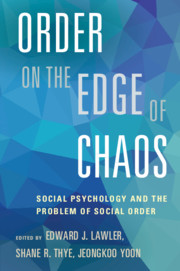Book contents
- Frontmatter
- Contents
- List of Contributors
- Preface
- 1 Social Psychology of Social Order: An Introduction
- 2 The Evolutionary Biology and Sociology of Social Order
- 3 Social Rationality and Weak Solidarity: A Coevolutionary Approach to Social Order
- 4 An Integrative Theory of Action: The Model of Frame Selection
- 5 The Center Cannot Hold: Networks, Echo Chambers, and Polarization
- 6 Social Exchange and Social Order: An Affect Theory Approach
- 7 Institutions, Trust, and Social Order
- 8 Identity Verifi cation and the Social Order
- 9 Identities, Roles, and Social Institutions: An Affect Control Account of Social Order
- 10 The Gender Frame and Social Order
- 11 Status, Power, and Social Order
- 12 Interaction Order: The Making of Social Facts
- 13 The Arts of Together: Social Coordination as Dyadic Achievement
- 14 Dignity as Moral Motivation: The Problem of Social Order Writ Small
- 15 The Legitimacy of Groups and the Mobilization of Resources
- Commentary: Contrasts and Complementarities
- Index
- References
11 - Status, Power, and Social Order
Published online by Cambridge University Press: 05 December 2015
- Frontmatter
- Contents
- List of Contributors
- Preface
- 1 Social Psychology of Social Order: An Introduction
- 2 The Evolutionary Biology and Sociology of Social Order
- 3 Social Rationality and Weak Solidarity: A Coevolutionary Approach to Social Order
- 4 An Integrative Theory of Action: The Model of Frame Selection
- 5 The Center Cannot Hold: Networks, Echo Chambers, and Polarization
- 6 Social Exchange and Social Order: An Affect Theory Approach
- 7 Institutions, Trust, and Social Order
- 8 Identity Verifi cation and the Social Order
- 9 Identities, Roles, and Social Institutions: An Affect Control Account of Social Order
- 10 The Gender Frame and Social Order
- 11 Status, Power, and Social Order
- 12 Interaction Order: The Making of Social Facts
- 13 The Arts of Together: Social Coordination as Dyadic Achievement
- 14 Dignity as Moral Motivation: The Problem of Social Order Writ Small
- 15 The Legitimacy of Groups and the Mobilization of Resources
- Commentary: Contrasts and Complementarities
- Index
- References
Summary
Abstract
Thomas Hobbes and Talcott Parsons have set the terms of the debate over the question of social order in society, but their view of order/disorder, even though each differs from the other, is both incomplete and problematic. A different approach is to see order/disorder as resulting from patterns of technical activity, social relations and reference group influences. Central here is a theory of social relations, based on the behavioral dimensions of status and power. Derivations from status-power theory include a theory of emotions, some of which (pride, shame, guilt, fear, sadness and contempt) tend to favor social order while others (mainly anger and sadness/depression) tend toward disorder. Reference groups also mainly dispose to sustaining order but, when contravening the role-expectations of interaction partners, also instigate disorder. Ironically, the highest levels of social order, as defined in status-power relational terms, are found to have the seeds of disorder contained within them.
We must wonder whether Thomas Hobbes ([1651] 1968), when he was postulating his state of nature with its war of all against all, knew he was erecting a straw figure. How can there be a war of all-against-all when individuals are necessarily raised in families, where parents necessarily nurture their children and children not only fear their parents but also love them? If there is any possible reality to Hobbes's grim picture, it would be strain and conflict between families. Yet, even here the picture is awry, since families are ordinarily members of larger groups and, even if only out of utilitarian self-interest, form coalitions and recruit allies from them. Within such collectivities, there must be some coordination and cooperation (Hechter and Horne 2003; Collins 2004) – that is, order – otherwise, even though enlarged, such groups would be feckless. In sum, Hobbes's depiction of the state of nature is a sociological fiction. What is not a fiction is that all individuals are sometimes in conflict with and fail to cooperate with some other individuals. This is disorder. But it cannot be that as Hobbes supposed all individuals are in conflict with all other individuals at the same time.
We must wonder too whether Talcott Parsons (1937, 1951), when he was solving the “Hobbesian problem of order” by postulating collectivities in which members shared values, knew that he too was erecting a straw figure. Family harmony or coordination and cooperation do not inevitably depend on common values.
- Type
- Chapter
- Information
- Order on the Edge of ChaosSocial Psychology and the Problem of Social Order, pp. 208 - 226Publisher: Cambridge University PressPrint publication year: 2015



